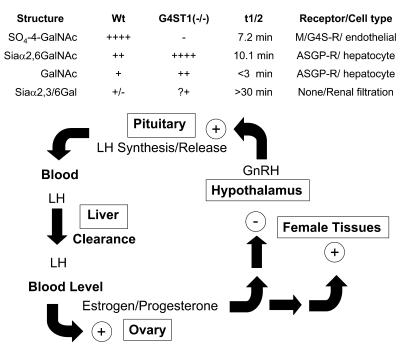Figure 1. Schematic of HPG axis.
The LH synthesized by WT mice bears N-linked oligosaccharides that terminate predominantly with SO4-4-GalNAc. Following GnRH-stimulated release into the blood, LH is rapidly removed from the blood by the Man/GalNAc-4-SO4-R expressed by endothelial cells in the liver, resulting in a half-life of 7.2 minutes in the blood. The amount of LH that reaches the LH receptor in the ovary and, as a result, the amount of estrogen/progesterone produced is determined by the half-life of LH. In the absence of GalNAc-4-4-ST1, the N-linked oligosaccharides on LH synthesized in the pituitary are predominantly modified with terminal Siaα2,6GalNAc. LH-bearing terminal Siaα2,6GalNAc is cleared by the ASGP-R expressed by hepatocytes, resulting in a longer half-life of 10.1 minutes. The longer half-life results in higher levels of LH in the blood and increased production of estrogen/progesterone by the ovary in GalNAc-4-ST1–/– mice as compared with WT mice. Thus, the rate of LH clearance and the concentration that LH attains in the blood are determined by the structures of its carbohydrate moieties. The strength of the signal produced by the same amount of LH released is determined by the structure of its terminal sugars. The impact of altered half-life appears to be superimposed on the other feedback mechanisms that normally regulate estrogen/progesterone levels. The same effects are seen in males with respect to T production.

